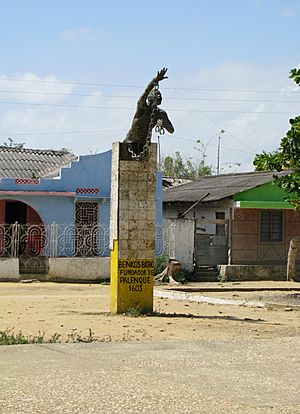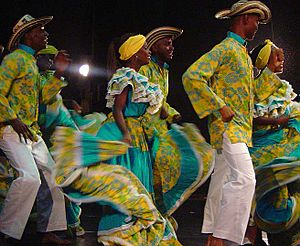San Basilio de Palenque facts for kids
Quick facts for kids
San Basilio de Palenque
|
|
|---|---|
|
Corregimiento
|
|

Statue of Benkos Biohó
|
|
| Country | Colombia |
| Department | Bolívar |
| Municipality | Mahates |
| Cultural space of Palenque de San Basilio | |
|---|---|
|
UNESCO Intangible Cultural Heritage
|
|

Fiesta in Palenque
|
|
| Country | Colombia |
| Reference | 00 |
| Region | South America |
| Inscription history | |
| Inscription | 2008 (3rd session) |
| List | Representative |
San Basilio de Palenque, also known as Palenque de San Basilio, is a special village in northern Colombia. Locals often call it Palenke. It is located in the Municipality of Mahates, in the Bolívar region.
This village is very important because it was the first free African town in the Americas. In 2005, UNESCO recognized it as a "Masterpiece of the Oral and Intangible Heritage of Humanity." This means its unique culture, traditions, and language are very valuable to the world.
Contents
A Place of Freedom: Palenque's History
Long ago, in the 1600s, many Africans were forced to come to South America by Spanish traders. They arrived by ship near Cartagena de Indias, an important port city. Some of these brave people managed to escape into the thick forests.
In 1619, a man named Domingo Biohó led about 30 runaways. They created a hidden community called Palenque de San Basilio. They fought against those who tried to capture them. Biohó declared himself King Benkos, and more people seeking freedom joined his community.
The Spanish tried to make peace with Biohó, but later they captured and executed him. Even so, the people of Palenque continued to fight for their freedom. They tried to help other enslaved Africans who arrived in Cartagena.
Eventually, the Spanish government issued a special rule in 1691. It said the people of Palenque de San Basilio could be free if they stopped helping new escapees. But people still found their way to freedom in San Basilio. Finally, in 1772, the Spanish agreed to a lasting peace. This made San Basilio de Palenque an officially free community.
Life in the Village
The village of San Basilio de Palenque has about 3,500 people. It sits at the foot of the Montes de María mountains, southeast of Cartagena. The word "palenque" means "walled city." Many such communities were built by escaped enslaved people in the 1600s as safe places. San Basilio is the only one of these original "palenques" that still exists today.
Most people in San Basilio are Afro-Colombian. They are direct descendants of the Africans who were brought to the Americas. They have worked hard to keep their old traditions and their unique language alive. In 2005, UNESCO recognized the village for its special culture.
The people of Palenque are mostly Black, and they still follow customs and speak a language from their African ancestors. In recent years, some people of indigenous background have also moved to the edges of Palenque. They were displaced by conflict in Colombia.
The Palenquero Language
 The language spoken in Palenque is called Palenquero. It is very special because it is thought to be the only Spanish-based creole language spoken in South America. A "creole language" is a new language that develops from a mix of different languages.
The language spoken in Palenque is called Palenquero. It is very special because it is thought to be the only Spanish-based creole language spoken in South America. A "creole language" is a new language that develops from a mix of different languages.
Palenquero's grammar is quite different from Spanish, so Spanish speakers usually cannot understand it. It was influenced by the Kikongo language from Congo and Angola, and also by Portuguese. Portuguese was the language of the traders who brought enslaved Africans in the 1600s.
In 2007, fewer than half of the village's 3,000 residents still spoke Palenquero. However, people are working hard to keep the language alive. Linguists (people who study languages) are creating a dictionary and a list of words for Palenquero.
Famous People from Palenque
- Benkos Biohó – The brave leader who helped found Palenque.
- Antonio Cervantes – A famous boxer.
- Evaristo Márquez – A well-known actor.
- Ricardo Cardona – A boxer.
- Prudencio Cardona – A boxer.
See also
In Spanish: San Basilio de Palenque para niños

